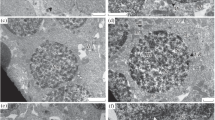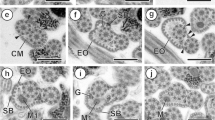Summary
The ultrastructure of spermatogonia and spermatocytes of Lithobius was studied. The spermatogonia show a nucleus with dispersed chromatin and a compact nucleolus. Their cytoplasm contains free ribosomes and polysomes; mitochondria and dictyosomes are not abundant.
During spermatocyte growth, nucleus and cytoplasm increase markedly in volume. The dispersion of the chromatin is more pronounced; the nucleolus shows frequent budding. Ribosomes, mitochondria, dictyosomes and endoplasmic reticulum are very numerous. New structures are (1) accumulations of concentric reticular saccules with a cytoplasmic center, (2) piles of narrow cisternae originating from the regular endoplasmic reticulum or from concentric saccules.
The synthetic activity during spermatocyte growth manifests itself by (1) numerous signs of nucleo-cytoplasmic exchanges, (2) an increase in the number of mitochondria and ribosomes, (3) a high activity of the Golgi apparatus. This is probably related to the gigantism of spermatocytes in Chilopoda.
Résumé
L'étude ultrastructurale des spermatogonies et des spermatocytes a été envisagée chez Lithobius forficatus L. (Myriapode Chilopode). Les spermatogonies présentent un noyau à chromatine dispersée dont le nucléole est condensé. Leur cytoplasme renferme des ribosomes, libres ou associés en polysomes; les mitochondries et les dictyosomes sont peu abondants.
Au cours de la croissance spermatocytaire, le noyau et le cytoplasme augmentent considérablement de volume. La dispersion de la chromatine est plus importante et le nucléole présente de nombreuses figures de bourgeonnement. Les ribosomes, les mitochondries, les dictyosomes et le reticulum endoplasmique sont très abondants. De nouvelles formations sont observables: 1) des amas de saccules réticulaires concentriques, délimitant une zone cytoplasmique; 2) des empilements lamellaires ayant leur origine soit dans le reticulum banal, soit dans les amas concentriques.
L'activité synthétique se manifeste lors de la croissance spermatocytaire par: 1) d'abondants échanges nucléo-cytoplasmiques; 2) une augmentation du nombre de mitochondries et des ribosomes; 3) une intense activité golgienne. Elle est vraisemblablement en rapport avec le gigantisme spermatocytaire observé chez les Myriapodes Chilopodes.
Similar content being viewed by others
Bibliographie
André, J.: L'évolution ultrastructurale du chondriome au cours de la spermatogénèse chez le Rat. Proc. European Regional Conf. Electron Microscopy, Delft 1960, vol. II, 947–950 (1960).
—: Contribution à la connaissance du chondriome. Etude de ses modifications ultrastructurales pendant la spermatogénèse. J. Ultrastruct. Res., Suppl. 3, 1–185 (1962).
—: Données récentes sur la physiologie des mitochondries. C.R. Soc. Biol. (Paris) 162, 7–12 (1968).
Boissin, L.: Gamétogénèse au cours du développement post-embryonnaire et biologie de la reproduction chez Hysterochelifer meridianus (L. Koch) (Arachnides, Pseudoscorpions). Thèse Doct. Sci. Nat., Montpellier (1970).
Burgos, M. H., Fawcett, D. W.: Studies on the fine structure of the mammalian testis. I. Differentiation of the spermatids in the cat (Felis domestica). J. biophys. biochem. Cytol. 1, 287–300 (1955).
Claude, A.: Origin and differentiation of membrane structures of the Golgi apparatus in the hepatic cell. 7ème Congr. Int. Micr. Electr., Grenoble, Favard, ed., 3, 85–86 (1970a).
—: Growth and differenciation of cytoplasmic membranes in the course of lipoprotein granule synthesis in the hepatic cell. I. Elaboration of the elements of the Golgi complex. J. Cell Biol. 47, 745–766 (1970b).
Clérot, J. C.: Mise en évidence par cytochimie ultrastructurale de l'émission de protéines par le noyau d'auxocytes de Batraciens. J. Microscopie 7, 973–992 (1968).
Cohn, Z. A., Fedorko, M. E.: Lysosomal form and function. In: Frontiers of biology, vol. 14: Lysosomes in biology and pathology, (Dingle, J. T., Fell, H. B., ed.), Amsterdam 1, 43–63 (1969).
Descamps, M.: Etude cytologique de la spermatogénèse chez Lithobius forficatus L. (Myriapode Chilopode). Arch. Zool. exp. gén. 110, 349–361 (1969a).
—: Etude cytochimique de la spermatogénèse chez Lithobius forficatus L. (Myriapode Chilopode). Histochemie 20, 46–57 (1969b).
— Les processus de dégénérescence des cellules sexuelles mâles chez Lithobius forficatus L. (Myriapode Chilopode). Arch. Zool. exp. gén. (1971) sous presse.
Dhainaut, A.: Etude en microscopie électronique et par autoradiographie à haute résolution des extrusions nucléaires au cours de l'ovogénèse de Nereis pelagica (Annélide Polychète). J. Microscopie 9, 99–118 (1970).
Favard-Sereno, C.: Evolution des structures nucléolaires au cours de la phase d'accroissement cytoplasmique chez le Grillon. J. Microscopie 7, 205–230 (1968).
Fawcett, D. W.: Intercellular bridges. Exp. Cell Res., Suppl. 8, 174–187 (1961).
—, Ito, S.: Observations on the cytoplasmic membranes of testicular cells, examined by phase contrast and electron microscopy. J. biophys. biochem. Cytol. 4, 135–142 (1958).
—, Slautterback, D.: The occurence of intercellular bridges in groups of cells exhibiting synchronous differentiation. J. biophys. biochem. Cytol. 5, 453–460 (1959).
Franke, W. W.: On the universality of nuclear pore complex structure. Z. Zellforsch. 105, 405–429 (1970).
Gabe, M., Martoja-Pierson, M.: Localisation histochimique des groupements SH dans quelques nucléoles. Ann. Histochim. 1, 230–236 (1956).
Gatenby, J. B., Tahmisian, T. N., Devine, R., Beams, H. W.: The orthopteran dictyosome. An electron microscope study. Cellule (Belg.) 59, 27–52 (1958).
Georges, D.: Spermatogénèse et spermiogénèse de Ciona intestinalis L. observées au microscope électronique. J. Microscopie 8, 391–400 (1969).
Gomori, G.: Une amélioration de la technique de détection histochimique des phosphatases acides. Stain Technol. 25, 81–85 (1950).
Gondos, B., Zemjanis, R.: Fine structure of spermatogonia and intercellular bridges in Macaca nemestrina. J. Morph. 131, 431–446 (1970).
Hannah-Alva, A.: The premeiotic stages of spermatogenesis. Advanc. Genet. 13, 157–226 (1965).
Hay, E. D.: Structure and function of the nucleolus in developing cells. In: The nucleus (Dalton, P. J., Haguenau, F., ed.). New York and London: Acad. Press 1968.
Joly, R., Descamps, M.: Evolution du testicule, des vésicules séminales et cycle spermatogénétique chez Lithobius forficatus L. (Myriapode Chilopode). Arch. Zool. exp. gén. 110, 341–348 (1969).
Kessel, R. G.: Annulate lamellae. J. Ultrastruct. Res., Suppl. 10, 1–82 (1968).
Nicander, L., Plöen, L.: Fine structure of spermatogonia and primary spermatocytes in Rabbits. Z. Zellforsch. 99, 221–234 (1969).
Novikoff, A. B.: In: Intracellular membranous structure. Japan Soc. Cell Biol., Okayama (Seno, S., Cowdry, E. V., ed.), 277–291 (1963).
—, Essner, E., Goldfischer, S., Heus, M.: In: The interpretation of ultrastructure. Symp. Intern. Soc. Cell Biol. (Harris, R. J. C., ed.), vol. 1, 149–192. New York: Academic Press 1962.
—, Quintana, N.: Golgi apparatus and lysosomes. Fed. Proc. 23, 1010–1022 (1964).
Palade, G. E.: Studies on the endoplasmic reticulum. II. Simple dispositions in cells in situ. J. biophys. biochem. Cytol. 1, 567–582 (1955).
Petrik, P., Collet, A.: Lamellar bodies in the epithelial brorichiolar cells in the mouse. Z. Zellforsch. 103, 232–237 (1970).
Rambourg, A., Chrétien, M.: Emploi de coupes épaisses pour l'étude de l'appareil de Golgi en microscopie électronique. 7ème Congr. Int. Micr. Elect., Grenoble, Favard, ed., 3, 83–84 (1970).
Shay, J. W., Biesele, J. J.: Ultrastructural observations on spermiogenesis in the cave cricket Ceutophilus secretus (Scudder). Cellule (Belg.), 67, 267–282 (1968).
Thiéry, J. P.: Mise en évidence des polysaccharides sur coupes fines en microscopie électronique. J. Microscopie 6, 987–1018 (1967).
Walker, M., MacGregor, H. C.: Spermatogenesis and the structure of the mature sperm in Nucella lapillus (L.). J. Cell Sci. 3, 95–104 (1968).
Zylberberg, L.: Contribution à l'étude de la spermatogénèse chez un Lépidoptère (Pieris brassicae L. Pieridae) Thèse Doct. Sci. Nat. Paris (1968).
Author information
Authors and Affiliations
Rights and permissions
About this article
Cite this article
Descamps, M. Etude ultrastructurale des spermatogonies et de la croissance spermatocytaire chez Lithobius forficatus L. (Myriapode Chilopode). Z. Zellforsch. 121, 14–26 (1971). https://doi.org/10.1007/BF00330914
Received:
Issue Date:
DOI: https://doi.org/10.1007/BF00330914




